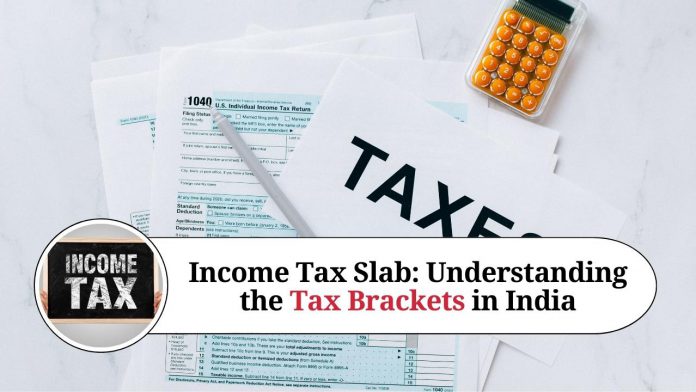Introduction:
Income Tax is a tax levied on the income earned by individuals, Hindu Undivided Families (HUFs), companies, firms, associations of persons (AOPs), and any other entities. In India, the income tax system is divided into different tax brackets, also known as “income tax slabs.” The amount of tax you pay depends on your income level and the tax slab you fall under.
Tax Slabs for Financial Year 2022-2023:
The Indian government has set different tax slabs for the financial year 2022-2023. Let’s take a look at them:
For individuals who are below the age of 60:
- Taxable income up to ₹2.5 lakh is exempt from tax
- Taxable income between ₹2.5 lakh and ₹5 lakh is taxed at 5%
- Taxable income between ₹5 lakh and ₹10 lakh is taxed at 20%
- Taxable income above ₹10 lakh is taxed at 30%
For individuals who are between the age of 60 and 80:
- Taxable income up to ₹3 lakh is exempt from tax
- Taxable income between ₹3 lakh and ₹5 lakh is taxed at 5%
- Taxable income between ₹5 lakh and ₹10 lakh is taxed at 20%
- Taxable income above ₹10 lakh is taxed at 30%
For individuals who are above the age of 80:
- Taxable income up to ₹5 lakh is exempt from tax
- Taxable income between ₹5 lakh and ₹10 lakh is taxed at 20%
- Taxable income above ₹10 lakh is taxed at 30%
Tax Deduction and Exemptions under Income Tax Slab
One of the ways to reduce the tax liability under the Income Tax Slab is by availing tax deductions and exemptions. These deductions and exemptions are offered to encourage individuals to invest in specific areas such as savings, insurance, health, education, and more.
Some of the popular tax deductions and exemptions under the Indian tax system are:
Section 80C: This section allows for a deduction of up to ₹1.5 lakh on investments in specified instruments such as Public Provident Fund (PPF), Employees Provident Fund (EPF), Equity-Linked Saving Schemes (ELSS), and more.
Section 80D: This section offers a deduction of up to ₹25,000 on health insurance premiums paid for self, spouse, children, and parents. An additional deduction of up to ₹50,000 is also allowed for senior citizens.
Section 80E: This section provides a deduction of up to ₹1.5 lakh on the interest paid on education loans taken for higher education.
House Rent Allowance (HRA): If you live in a rented house, you can claim a deduction for the rent paid under HRA. The amount of deduction depends on the amount of HRA received and the actual rent paid.
Standard Deduction: A standard deduction of ₹50,000 is allowed for salaried individuals in the financial year 2022-2023.
It’s essential to note that these deductions and exemptions are subject to change from time to time, and it’s advisable to keep yourself updated with the latest tax laws.
Impact of Taxable Income on Tax Liability
The amount of tax you pay under the Income Tax Slab is directly proportional to your taxable income. Taxable income is the total income earned by an individual in a financial year, after deducting eligible exemptions and deductions. The more taxable income you have, the higher your tax liability will be.
For example, if your taxable income is ₹6 lakh, you will fall under the tax bracket of ₹5 lakh to ₹10 lakh, and your tax liability will be ₹25,000 (5% of ₹2.5 lakh + 20% of ₹1.5 lakh). On the other hand, if your taxable income is ₹12 lakh, you will fall under the tax bracket above ₹10 lakh and your tax liability will be ₹3.3 lakh (30% of ₹12 lakh).
It’s important to note that different sources of income are taxed differently. For example, income from salary is taxed differently from income from rental properties, capital gains, or business income. Additionally, tax rates for companies and firms are different from tax rates for individuals and HUFs.
Tax Planning and Investment Strategies
Tax planning and investment strategies can help you reduce your tax liability and increase your overall wealth. By making smart investments and availing tax deductions and exemptions, you can reduce your taxable income and pay less tax. Here are some tips for tax planning and investment:
- Make use of tax-saving investments such as PPF, EPF, ELSS, and more, to avail of deductions under Section 80C.
- Buy health insurance for yourself, spouse, children, and parents to avail of deductions under Section 80D.
- Invest in education loans for higher education to avail of deductions under Section 80E.
- Rent a house instead of owning one, as you can claim deductions for HRA.
- Consider investing in long-term capital gain (LTCG) instruments, such as mutual funds, as LTCG is taxed at a lower rate compared to short-term capital gain (STCG).
By following these tax planning and investment strategies, you can not only reduce your tax liability but also build wealth for the future.
E-filing of Income Tax Return
The Indian government has made it easier for taxpayers to file their income tax return with the introduction of e-filing. E-filing is the process of filing your income tax return online using the official website of the Income Tax Department of India. The benefits of e-filing include a quick and hassle-free process, the ability to track the status of your return, and reduced errors compared to manual filing.
To e-file your income tax return, you will need to have a PAN (Permanent Account Number), a bank account, and a registered email address. You can e-file your return yourself or take the help of a tax expert or an online tax filing platform.
Conclusion
Income Tax Slab is an essential aspect of the Indian tax system and helps the government to collect revenue to fund various welfare programs and development activities. Understanding the Income Tax Slab and the various tax deductions and exemptions is crucial for managing your finances and ensuring you pay the right amount of tax. With the convenience of e-filing, it has never been easier to file your income tax return and keep track of your tax liabilities.
With smart tax planning and investment strategies, you can reduce your tax liability and increase your overall wealth.
Frequently Asked Questions (FAQs)
- What is the Income Tax Slab in India?
The Income Tax Slab in India is a tax bracket system based on the taxable income of an individual. The government sets tax rates for different tax brackets, and individuals are taxed at the applicable rate based on their taxable income.
- Who is eligible to pay income tax in India?
All individuals, Hindu Undivided Families (HUFs), firms, companies, and other entities earning income in India are eligible to pay income tax.
- What is taxable income?
Taxable income is the total income earned by an individual in a financial year, after deducting eligible exemptions and deductions.
- How is income tax calculated in India?
Income tax is calculated by multiplying the taxable income by the applicable tax rate. Taxable income is calculated by subtracting eligible exemptions and deductions from the total income earned.
- What are the different tax brackets under the Income Tax Slab in India?
The different tax brackets under the Income Tax Slab in India are:
- Up to ₹2.5 lakh: NIL
- ₹2.5 lakh to ₹5 lakh: 5%
- ₹5 lakh to ₹10 lakh: 20%
- Above ₹10 lakh: 30%
- Can I claim deductions and exemptions to reduce my tax liability?
Yes, individuals can claim eligible deductions and exemptions under the Indian tax system to reduce their tax liability. Some popular tax deductions and exemptions include Section 80C, Section 80D, Section 80E, House Rent Allowance (HRA), and more.
- What is the standard deduction under the Income Tax Slab?
The standard deduction under the Income Tax Slab is a fixed amount of ₹50,000 allowed for salaried individuals in the financial year 2022-2023.
- What is e-filing of Income Tax Return?
E-filing of Income Tax Return is the process of filing your income tax return online using the official website of the Income Tax Department of India.
- What are the benefits of e-filing of Income Tax Return?
The benefits of e-filing of Income Tax Return include a quick and hassle-free process, the ability to track the status of your return, and reduced errors compared to manual filing.
- What do I need to e-file my Income Tax Return?
To e-file your Income Tax Return, you will need a PAN (Permanent Account Number), a bank account, and a registered email address.




















